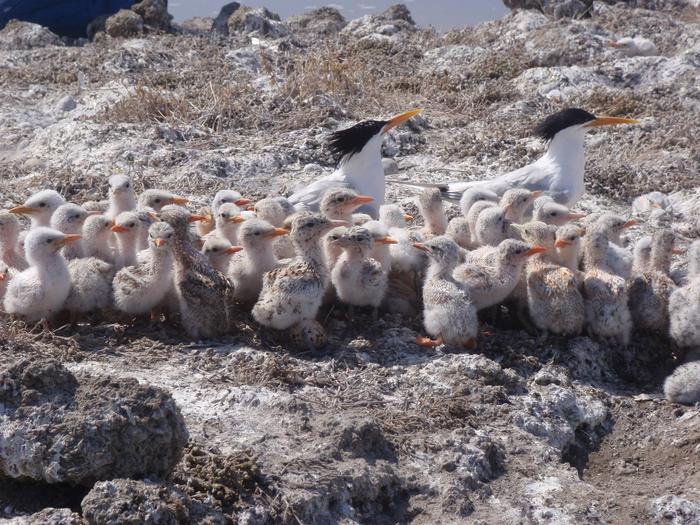San Diego Bay National Wildlife Refuge
Fish and Wildlife Service, California.
The San Diego Bay National Wildlife Refuge protects a rich diversity of endangered, threatened, migratory, and native species and their habitats in the midst of a highly urbanized coastal environment. The Refuge is situated at the south end of San Diego Bay and is surrounded by the Cities of National City, Chula Vista, San Diego, Imperial Beach, and Coronado. Established to protect endangered and threatened species, the Refuge encompasses approximately 2,620 acres of land and water in and around San Diego Bay.
Nesting, foraging, and resting sites are managed for a diverse assembly of birds. Waterfowl and shorebirds over-winter or stop here to feed and rest as they migrate along the Pacific Flyway. Undisturbed expanses of cordgrass dominated salt marsh support sustainable populations of light-footed Ridgway's rail.
Enhanced and restored wetlands provide new, high-quality habitat for fish, birds, and coastal salt marsh plants, such as the endangered salt marsh bird’s beak. Quiet nesting areas, buffered from adjacent urbanization, ensure the reproductive success of the threatened western snowy plover, endangered California least tern, and an array of ground nesting seabirds and shorebirds.
The San Diego Bay National Wildlife Refuge also provides the public with the opportunity to observe birds and wildlife in their native habitats and to enjoy and connect with the natural environment. Informative environmental education and interpretation programs expand the public’s awareness of the richness of the wildlife resources of the Refuge. The Refuge serves as a haven for wildlife and the public to be treasured by this and future generations.
The San Diego National Wildlife Refuge consists of the Sweetwater Marsh and South San Diego Bay Units. Most of what remains of San Diego Bay’s historic coastal salt marsh and intertidal mudflat habitat is preserved within these two refuge units.
Sweetwater Marsh Unit
Sweetwater Marsh is 316 acres in size and was established in 1988 on the east side of San Diego Bay. It is located on the east side of San Diego’s south bay and has a rich cultural history. The Kumeyaay peoples first used the area for fishing, hunting and gathering. On this site during World War I, a 30-acre kelp processing plant produced potash, a key ingredient in smokeless gunpowder, for the British Army. This is a certain area on the Refuge called “Gunpowder Point.” Today, the refuge is not only home for native wildlife, but is also the headquarters location for the San Diego National Wildlife Refuge Complex.
Habitats at Sweetwater Marsh support species such as the California least tern, Western snowy plover, osprey, belted kingfisher, as well as a rare salt marsh plant found in few other places, Palmer’s frankenia.
This refuge is also the site of a very successful breeding program for the endangered light-footed clapper rail, carried out in partnership with the non-profit Living Coast Discovery Center, Sea World San Diego, and the San Diego Zoo’s Safari Park. Hundreds of light-footed Ridgway’s rails have been reared and released into the wild through this program. A variety of native birds can be seen up close both in the aviaries and during educational bird presentations by the nature center’s volunteers and staff. Environmental education programs, activities and special events are offered throughout the year by the refuge complex and the nature center. It is a great place to visit!
South San Diego Bay Unit
Dedicated in 1999, the 2,300-acre South San Diego Bay Unit was established to shelter, protect and restore habitat for hundreds of thousands of birds migrating along the Pacific Flyway, as well as for the bay’s resident species. The South San Diego Bay Unit is located in the southernmost tip of the San Diego Bay; within the cities of Imperial Beach, Coronado, National City, and City of San Diego.
Eelgrass beds and the largest contiguous mudflat in southern California provide a supermarket for overwintering waterfowl, seabirds, shorebirds and migrating Pacific green sea turtles. The South San Diego Bay Unit of the refuge also provides foraging and nesting habitat for thousands of nesting seabirds in spring and summer. The unit supports such endangered and threatened species such as the California least tern, Belding’s savannah sparrow and western snowy plover.
Restoration of tidal flats, salt marsh, subtidal, and native upland habitat continues to provide additional habitat essential to birds, native plants, fish and other marine life.
The public can birdwatch, walk and ride bicycles along a bike path around the bay or participate in monthly tours of the refuge. Hundreds of school children use the refuge as an outdoor classroom for refuge-sponsored environmental education programs.
Nearby Activities
- Birding
- Fishing
- Hiking
- Motor Boat
- Wildlife Viewing
Directions
Plug into your GPS: 1080 Gunpowder Point Dr. Chula Vista, CA 91910. To get here from I-5 freeway, exit E street exit and turn west into the entrance of the free parking lot and shuttle stop, where E street intersects Bay Boulevard.
Open from 10am - 5pm, Wednesday to Sunday, a shuttle bus run by the Living Coast Discovery Center will bring your inside the refuge gates about every 15 minutes. Check the Living Coast Discovery Center website for most up-to-date information. There is no fee to walk the 1.5 miles of trails, however there is a fee to explore the Living Coast Discovery Center. Both the Discovery Center and our administrative headquarters are located next to each other.

